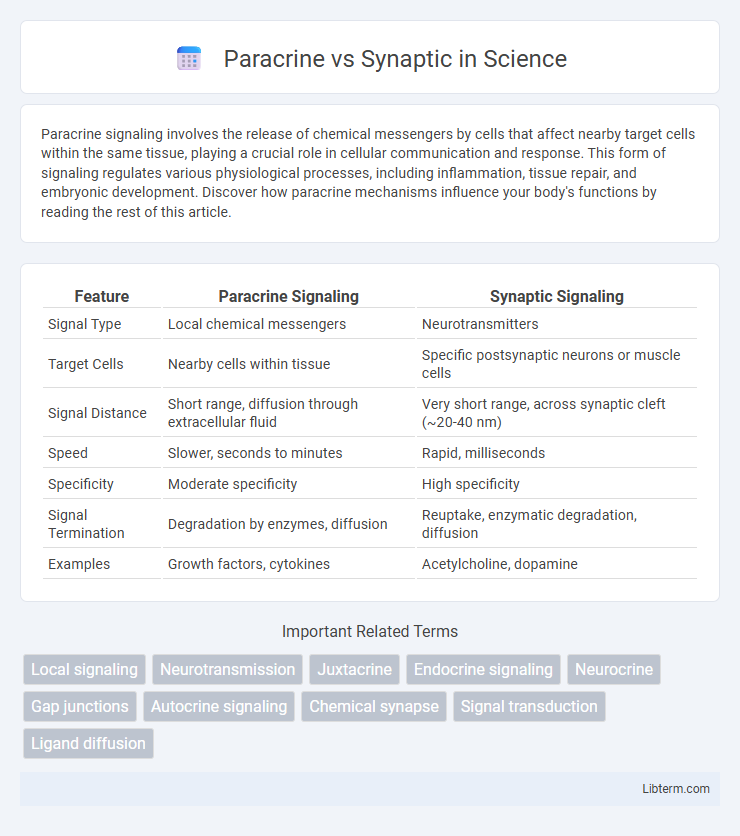Paracrine signaling involves the release of chemical messengers by cells that affect nearby target cells within the same tissue, playing a crucial role in cellular communication and response. This form of signaling regulates various physiological processes, including inflammation, tissue repair, and embryonic development. Discover how paracrine mechanisms influence your body's functions by reading the rest of this article.
Table of Comparison
| Feature | Paracrine Signaling | Synaptic Signaling |
|---|---|---|
| Signal Type | Local chemical messengers | Neurotransmitters |
| Target Cells | Nearby cells within tissue | Specific postsynaptic neurons or muscle cells |
| Signal Distance | Short range, diffusion through extracellular fluid | Very short range, across synaptic cleft (~20-40 nm) |
| Speed | Slower, seconds to minutes | Rapid, milliseconds |
| Specificity | Moderate specificity | High specificity |
| Signal Termination | Degradation by enzymes, diffusion | Reuptake, enzymatic degradation, diffusion |
| Examples | Growth factors, cytokines | Acetylcholine, dopamine |
Introduction to Cell Communication
Cell communication involves various signaling methods, with paracrine and synaptic signaling being key types. Paracrine signaling uses chemical messengers that diffuse over short distances to influence nearby cells, crucial in tissue development and immune responses. Synaptic signaling relies on neurotransmitters released into synaptic clefts, enabling rapid and targeted communication between neurons in the nervous system.
Defining Paracrine Signaling
Paracrine signaling involves the release of chemical messengers by cells to affect nearby target cells within a local environment, typically through the extracellular fluid. This form of cell communication is crucial in modulating physiological processes such as inflammation, tissue repair, and development by influencing neighboring cells without entering systemic circulation. Unlike synaptic signaling, which relies on neurotransmitter release across a synaptic cleft between neurons, paracrine signaling impacts multiple cell types in close proximity through diffusion of signaling molecules.
Overview of Synaptic Signaling
Synaptic signaling involves the transmission of electrical or chemical signals between neurons at specialized junctions called synapses. This process enables rapid and precise communication by releasing neurotransmitters directly into the synaptic cleft, which bind to receptors on the postsynaptic cell. Synaptic signaling plays a crucial role in neural networks by facilitating fast synaptic transmission critical for brain function and coordinated responses.
Key Differences Between Paracrine and Synaptic Signaling
Paracrine signaling involves the release of signaling molecules that affect nearby cells within the local tissue environment, whereas synaptic signaling occurs specifically between neurons through synapses, allowing rapid and targeted neurotransmitter transmission. Paracrine signals diffuse through the extracellular fluid and influence multiple target cells non-selectively, while synaptic signals are highly localized and precise, impacting only the post-synaptic neuron. The temporal and spatial specificity of synaptic signaling contrasts with the broader, slower, and more sustained effects typical of paracrine communication.
Molecular Mechanisms in Paracrine Communication
Paracrine communication relies on the diffusion of signaling molecules, such as growth factors, cytokines, and neurotransmitters, which bind to surface receptors on nearby target cells, triggering specific intracellular signaling cascades like the MAPK or PI3K pathways. Unlike synaptic signaling, which involves rapid, highly localized neurotransmitter release within a synaptic cleft, paracrine signaling operates over short distances without specialized synaptic structures, leading to a modulated, often slower cellular response. Key molecular mechanisms include the secretion of ligands, receptor activation, second messenger generation, and subsequent transcriptional changes that regulate tissue-specific functions and cellular responses.
Synaptic Transmission: Process and Players
Synaptic transmission involves the release of neurotransmitters from the presynaptic neuron into the synaptic cleft, which then bind to specific receptors on the postsynaptic neuron, facilitating rapid and targeted signal propagation. Key players in this process include voltage-gated calcium channels that trigger vesicle fusion, synaptic vesicles containing neurotransmitters, and receptor proteins such as ionotropic and metabotropic receptors on the postsynaptic membrane. Efficient synaptic transmission is essential for neural communication, underlying processes like sensory perception, motor coordination, and cognition.
Functional Roles in the Nervous System
Paracrine signaling in the nervous system involves the release of chemical messengers that affect nearby cells, modulating local neuronal activity and supporting processes such as inflammation, repair, and synaptic plasticity. Synaptic signaling enables rapid, precise communication between neurons through specialized junctions called synapses, crucial for transmitting electrical impulses and coordinating neural networks. These distinct mechanisms facilitate both localized modulation and fast, targeted neuronal communication essential for brain function and adaptability.
Examples of Paracrine Signaling in Physiology
Paracrine signaling plays a crucial role in wound healing where growth factors like platelet-derived growth factor (PDGF) stimulate nearby cells to proliferate and repair tissue. In the immune system, cytokines such as interleukin-1 (IL-1) act locally to modulate inflammation and activate neighboring immune cells. Paracrine communication also regulates blood vessel formation through vascular endothelial growth factor (VEGF) released by hypoxic cells, promoting angiogenesis within the local environment.
Clinical Implications: Disorders and Therapeutic Targets
Paracrine signaling dysregulation is implicated in inflammatory diseases and cancer, making cytokine inhibitors valuable therapeutic targets. Synaptic transmission defects underlie neurological disorders like Alzheimer's and Parkinson's, where modulating neurotransmitter receptors offers clinical benefits. Understanding these distinct signaling pathways enables precise drug development for autoimmune diseases and neurodegenerative conditions.
Summary: Choosing Between Paracrine and Synaptic Pathways
Paracrine signaling involves the release of chemical messengers that affect nearby cells within a localized area, allowing for broad but targeted cellular communication. Synaptic signaling, characterized by neurotransmitter release across a synaptic cleft, enables rapid and highly specific transmission between neurons. Choosing between paracrine and synaptic pathways depends on the required signaling speed, distance, and specificity of the cellular response.
Paracrine Infographic

 libterm.com
libterm.com